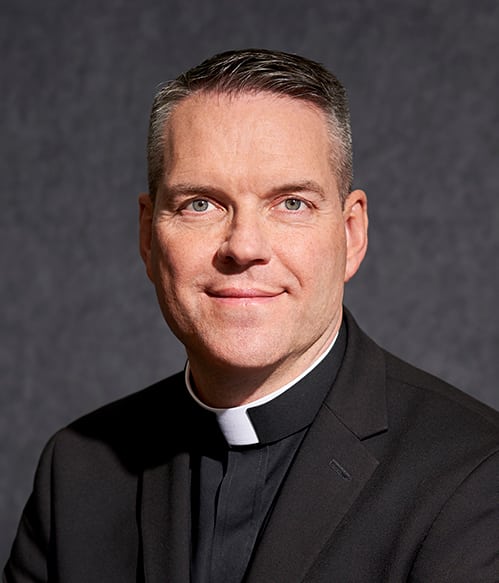Saint Mary's Newsroom
Campus ConnectionAn update from the president to alumni and parents
United Nations’ Sustainable Development Goals fall behind initial hopes, lacks needed funding
In 2000, United Nations member states adopted eight Millennium Development Goals (MDGs), which featured a number of ambitious global initiatives, such as eradicating extreme poverty and hunger, and achieving universal primary education in all countries around the world.
As these goals were extremely aspirational, most were far from met by the target date. However, by 2015 significant progress was made in a few areas, such as increased official development assistance (foreign aid), reduced trade barriers for developing country exports, and new debt-reduction strategies for some of the heaviest indebted countries. By the target date of the MDGs, the most notable outcome was the number of people living in extreme poverty around the world had been reduced by 50% since 1990.
To keep the sustainable development agenda moving forward, at the end of 2015, the United Nations member states adopted 17 new Sustainable Development Goals (SDGs) to be met by 2030.
“The new SDGs carry over some of the same aspirational initiatives from the MDGs, such as eliminating poverty and achieving zero hunger, but have also added some new goals, which may arguably be more attainable in the near term, such as affordable and clean energy; climate action; and reduced inequality,” says Matt Bluem, Ph.D., assistant dean of graduate programs and MBA program director at Saint Mary’s University of Minnesota’s School of Business and Technology.
Since the adoption of the SDGs in 2015, some progress has been on two of the SDGs: eliminating preventable deaths among newborns and children under the age of 5, and getting children into primary schools. These are both important initiatives and progress should be celebrated, Bluem says.
Unfortunately, progress on the other 15 goals has not kept pace. With just 10 years until the target date for meeting all 17 SDGs, it is becoming increasingly clear that most of these goals will not be met.
“Initiatives such as eliminating extreme poverty, ending hunger, and protecting the climate are quite far from being achieved — and in some cases, are going in the wrong direction,” Bluem says.
According to the UN, the biggest challenge in meeting the SDGs is funding. An additional $2-3 trillion is needed to help meet funding requirements. A recent report by the Brookings Institution states that sub-Saharan Africa alone would need hundreds of billions of dollars in additional financial support every year in order to meet the SDGs by the target date of 2030, Bluem says.
U.N. Secretary-General António Guterres has argued that public investment by governments is not enough, insisting that private industry is going to need to get involved. To meet the aggressive SDGs, the private and public sectors will need to work together to bring about the investment and policy change.
In order to encourage governments and the private sector to put the resources and effort necessary into meeting the SDGs, it is imperative to let world leaders know that goals such as the SDGs are important to the international citizenry, Bluem says.
“In a time that sees the United States withdraw from a vital initiative such as the Paris Climate Agreement, we all need to get involved to get efforts back on track,” Bluem says. “In the end, even if we are not able to fully meet the SDGs, perhaps their greatest value will be in bringing greater attention and focus to the imperative of sustainable development.”
Are you a journalist covering this topic and interested in an interview? That’s where we can help.
Matt Bluem, Ph.D., program director of M.A. in International Development, has taught business and marketing courses at Saint Mary’s University of Minnesota since 2008. Prior to Saint Mary’s, he worked in both the banking and the nonprofit sectors, most recently with a non-governmental organization (NGO) with operations in more than a dozen countries.
Bluem is an expert in political and economic development and is available to speak with media. To arrange an interview with him, simply click on his photo below to access his contact information.
Connect with:
Matt Bluem, Ph.D.
 Assistant Dean of Graduate Programs, MBA Director, School of Business and Technology
Assistant Dean of Graduate Programs, MBA Director, School of Business and Technology
Expertise: International Development, Political and Economic Development
View profile
Ants and plants, a mutually beneficial relationship
Ant-plant interactions are really common in nature, and while people might most often picture ants as carrying pieces of leaves cut from tropical plants, ant behavior in the Midwest is less appreciated.
Moni Berg-Binder, Ph.D., associate professor of biology at Saint Mary’s University, finds ant mediated seed dispersal, called myrmecochory, fascinating and says that the temperate deciduous forests here in North America have many examples of plants that engage with the native plant community.
“In myrmecochory, these plants, often spring ephemerals, which are early blooming spring plants, produce seeds with a nutritious structure that sticks off the seed called an elaiosome,” she said. “Typically what happens is the seeds fall to the ground which is called primary dispersal. The Ants forage and find the seeds on the ground and then pick up seeds and carry them to their nest. This is secondary dispersal. Then, once they get the seeds into their nests, those seeds are brought to places where developing larvae eat the elaiosome. But the seed is unharmed.”
From there, she said the seeds are then deposited in a chamber inside of their nests or they may take the seeds and put them in a refuse pile or a garbage dump just outside the nest. Ants, apparently, keep a very clean nest.
And oftentimes the ground soil around ant activity, is elevated in organic matter, nitrogen, phosphorous, possibly moisture — all really good things for plants and essentially the same thing as fertilizer. So the seed flourishes.
“It’s a beautiful example of mutualism,” she said. “The seed is taken and has effectively been planted inside this nest with nature’s fertilizer. The win from the ant perspective is that they received food.”
Dr. Berg-Binder and her students have focused their research on a plant called bloodroot. Local ants disperse the seeds of bloodroot.
Dr. Berg-Binder became interested in plant interactions while in graduate school when she became intrigued by the win-win scenario of mutualism. For her graduate work, she had been interested in conservation and how invasive species are introduced to a natural area where they did not typically belong. These invasive species can engage in mutualism with native species.
She said there is much more studying to be done on the relationship native ants have with both native plants and invasive plants.
Are ants helping the invasive species become more invasive? “They’re a great study system, and I find them really fascinating,” she said.
Are you looking to know more about invasive species or ant and plant interactions? Or, are you a journalist covering this topic and looking to book an interview? That’s where we can help.
To book an interview with Dr. Moni Berg-Binder, simply click on her photo below to access her contact information.
Connect with:
Moni Berg-Binder, Ph.D.
Associ ate Professor, Biology
ate Professor, Biology
Expertise: Invasive plant species and native plants; ecology and animal-plant interactions
View profile

A passion to serve: Saint Mary’s educator balances higher ed schedule with volunteer firefighting, emergency services
George Diaz M’10 claims that he has plenty of time for hobbies. They include taking a joy ride on his motorcycle and enjoying outdoor culinary arts such as grilling.
Given his daily lists of responsibilities, though, one could assume he might not get as much downtime as he would like. Not only does Diaz teach classes in the M.A. in Organizational Leadership program at Saint Mary’s University of Minnesota’s Twin Cities Campus, but he is also currently finishing up his Ed.D. in Leadership here.
He also serves as a firefighter in his adopted town of Hanover, Minn. He’s one of 26 volunteers who are on call at various parts of the week to watch after the people and buildings of Hanover and three neighboring communities in the far west of the Twin Cities metro area. Oh, and after completing advanced technical rescue training, he is also a member of the Wright County Special Response Unit based out of nearby Monticello — and he and his wife, Heather, have two children under the age of five.
Still, the man who had studied to be a police officer 19 years ago would not have it any other way.
When Diaz and his wife moved to Hanover in 2014, he quickly heard about the need to recruit more volunteer firefighters to the local operation. That same year, he began working at Saint Mary’s as an assistant professor. He could never imagine how much his academic and pedagogical pursuits would fall in line with his call to public service.
“When I left the law enforcement world, I always had some kind of urgency or want or need to go back to that field. My career path changed significantly, but I missed it,” Diaz said. “It was a decision that I didn’t know how much was going to change my life and my family’s life for the better.”
A higher cause
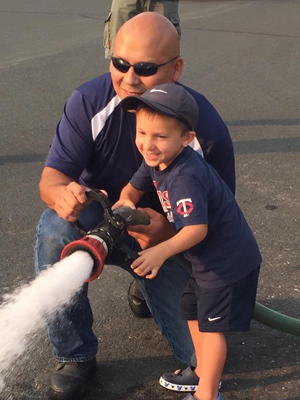
George Diaz M’10 shows his son, Sam, how to use the fire hose. Says Diaz: “When we’re out in the community, the kids will remember that we were at their schools and come talk to us.”
Perhaps there is no more defined correlation between Diaz’s two worlds as educator and civic protector than his involvement with the Minnesota Firefighters Foundation (MNFFF), a nonprofit organization that provides educational services for cancer prevention and raises funds for fire departments throughout the state.
As a member, Diaz has been part of a team to raise money for new hoods for rural fire departments with old and ineffective equipment. In 2019, as part of its “Hoods4Heroes” campaign, the foundation was able to purchase 500 hoods, valued at $100 each. As Diaz will tell you, the cancer-causing carcinogens largely enter the body through the neck and ear areas, making updated equipment a necessity.
Most fire departments run as both government agencies and nonprofits, Diaz said.
“The bridge between both the nonprofit and the government aspect is something you’ll see a lot in regular nonprofit and government contracts, where one relies upon the other, but that relationship alone has not been studied very well,” he said. “And there aren’t many degrees that look into it.”
To address dynamics such as these, Diaz helped develop the online M.A. in Public Administration program at Saint Mary’s, which started in 2018. The program had its first two graduates finish this past fall.
“When we teach people to be leaders, they’re going to be answering questions that have no answers. They just have to find the best next solution. That answer may not be the same tomorrow, because that answer is based on what we know right now and who we are with.”
—George Diaz
Diaz is proud of the partnership the MNFFF has formed with the University of Minnesota Masonic Cancer Center to conduct cancer research on firefighters in the Twin Cities metro area. As part of the study this spring, a group of firefighters will have their carcinogen levels monitored over extended periods of time to get more insight into the exposure to certain harmful cancer-causing chemicals they may encounter when putting out fires.
Based on the results, the foundation will work with the center to provide new recommendations to mitigate that exposure for firefighters.
When it comes to handling an actual fire, Diaz and his colleagues often resort to a tactic that he stresses to his students: Find your next best right answer.
“When we teach people to be leaders, they’re going to be answering questions that have no answers,” he said. “They just have to find the best next solution. That answer may not be the same tomorrow, because that answer is based on what we know right now and who we are with.”
The path of discovery
Diaz moved from the South Side of Chicago to Rochester, Minn., during his last year of junior high school.
After graduating from high school in 1999, his first inclination was to become a police officer. He pursed his associate’s degree in law enforcement at the local community college. During the last year of the program, though, his interest in a four-year degree began to grow. He enrolled at the University of Minnesota-Duluth on his way to a bachelor’s degree in criminology in 2005, before deciding to earn a history degree at The College of St. Scholastica in 2007 with the intention of applying to law school.
Diaz was accepted to the William Mitchell College of Law, but decided not to enroll. Around the same time in 2008, he was offered a position as a paralegal in the Hennepin County Attorney’s Office on its felony property unit before helping run a K-12 truancy prevention program.
During 2008, Diaz also began his relationship with the Twin Cities Campus at Saint Mary’s by starting to take classes for an M.A. in Counseling and Psychological Services.
“It was the course offerings that drew me into Saint Mary’s,” Diaz says. “It was really the culture that kept me here.”
Before earning his degree in 2010, though, he spent his last year taking human development courses — one of which was an elective course taught by Susan Hines, Ed.D.
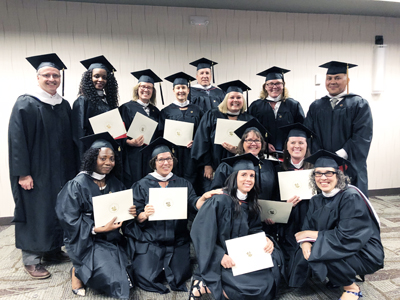
George Diaz M’10 (top right) poses with the members of the M.A. in Organizational Leadership program at a recent graduation.
“I can still picture George in my class,” Hines said. “He was a good student who was curious and always engaged in the classroom learning. This, along with his easy-going attitude and unflappable nature, really stood out to me and his classmates.”
Initially, he took the course simply because it fit his schedule before earning an M.A. in Human Development. Yet, a side conversation about his post-graduation plans with Hines would help compel him to start the Ed.D. program the next semester.
“She said, ‘Why don’t you work in education if you like it so much?’ And that’s where it really started,” Diaz said. “The aha! moment came about.”
Diaz always tells his students to ask as many questions as they can during their educational journey, given the insight those answers can possess to questioning minds — just like his own.
“If you don’t know the reasoning behind it, then you’re never going to remember it and it’s not worth your time learning it,” Diaz said. “Yes, some things will resonate with you; others won’t. But always understand why something does or does not.”

Student’s fundraising efforts turn tragedy to triumph
For Saint Mary’s University student Aimee Boggs ’20, hearing that her hometown school was in need of help was heartbreaking. Largely because of her ongoing fundraising efforts for the school, a tragic turn of events has turned into an uplifting story of generosity.
On Jan. 5, a trailer used for offices and storage at the De La Salle Blackfeet School in Browning, Mont., was vandalized and set on fire. This act of violence was especially tough for the Lasallian school, which Boggs said depends largely on volunteers and philanthropic gifts.
“I was upset because the school has been such a blessing to the Blackfeet community,” Boggs said. “Everybody from my siblings to my nephews have gone to this school, so to hear that someone would cause that type of damage to a school that not only runs on donations, but has been a light to our community, is devastating.”
Within just one day, Boggs, a 2012 graduate of De La Salle Blackfeet School, started a Facebook Fundraiser, with the hope of raising $20,000, to help the school purchase another trailer and replace its contents.
In less than a month, she has raised over $9,330. Additionally, she helped promote an ice-skating fundraiser for De La Salle, sponsored by the Office of Campus Ministry, and a hockey jersey raffle, made possible by the Athletics Department, both held Jan. 26 on the Winona Campus. Also that day, a collection was taken at Mass. About 75 people attended the ice-skating event, and these combined efforts raised just over $507.
“It’s great to see how quickly we have raised the money, and it’s cool to see how many people have shared the post,” Boggs said. “It just shows how supportive the Lasallian community is and how tight knit we actually are. To see the outpouring of love and support for our community has been heartwarming.”
Boggs hopes to keep her fundraiser going until her goal is met. Donations to the De La Salle Blackfeet School can also be sent directly to P.O. Box 1489, Browning, MT, 59417
This spring student volunteers with S.O.U.L. (Serving Others United in Love) will be completing a service trip to the school as well. Boggs serves as president of S.O.U.L., and her best friend and roommate will be leading this trip.
Boggs said the school serves about 75 students in grades four through eight. But she describes it as more than a school: “It is kind of like Saint Mary’s in the sense that we had so much individualized attention from our teachers,” she said. “And the Brothers made that school what it is. I felt safe and supported, and I looked forward to going every single day. I don’t think I ever missed school. Without De La Salle I wouldn’t be at Saint Mary’s. I probably wouldn’t be in college. It was literally my second home.”

Saint Mary’s furthers collaboration with Mayo Clinic Health System through athletics partnership
WINONA, Minn. — Saint Mary’s University of Minnesota and Mayo Clinic Health System – Franciscan Healthcare have entered into a joint venture focused on athletics.
“At Saint Mary’s, the health and well-being of our student-athletes is always our top priority,” said Brian Sisson, athletic director for Saint Mary’s University. “We are thrilled to be joining forces with Mayo Clinic Health System — a trusted leader in healthcare worldwide — which will create an unmatched experience for each and every one of our student-athletes.”
Through this partnership, Mayo Clinic Health System will provide Cardinal student-athletes additional sports medicine and athletic training care, as well as access to comprehensive health care services and professionals. The addition of a Mayo Clinic team doctor and a fourth athletic trainer to the department will assist in day-to-day services throughout the academic year and will further enhance the overall well-being, health, and safety of all Cardinal student-athletes.
“The entire team we have worked with to make this a reality has been truly amazing,” added Sisson. “We are grateful to have Mayo Clinic Health System as part of the Cardinal athletics team moving forward and know that this collaboration will set us apart among current and future student-athletes at Saint Mary’s.”
“The health and safety of athletes, including student-athletes, is very important to Mayo Clinic Health System and the Winona area community,” said Paul Mueller, M.D., regional vice president, Southwest Wisconsin Region, Mayo Clinic Health System. “Given our success with other similar regional partnerships, such as at the University of Wisconsin-La Crosse, we are confident we will replicate this level of service and expertise here in Winona at Saint Mary’s University.”
Alecia Gende, D.O., a member of the Mayo Clinic Health System sports medicine team, has been named medical director of Saint Mary’s athletics. Dr. Gende will offer consistent guidance to the university training room facilities with Mayo Clinic Health System athletic training staff.
“We are all excited about this new partnership and the many tangible benefits for both institutions,” said Dr. Gende. “We look forward to providing high-quality care to these amazing student-athletes that supports their overall performance.”
This joint venture furthers Saint Mary’s collaborative relationship with Mayo Clinic, which includes the 3+2 Physician Assistant Program launched in 2019. In that program, students spend three years taking classes at the new Science and Learning Center on the Winona Campus. The following two years, program participants learn from Mayo Clinic School of Health Sciences faculty at Saint Mary’s University’s Rochester Campus and have clinical learning experiences at Mayo Clinic in Rochester and throughout Mayo Clinic Health System.
“This is truly going to be a model learning environment for students to transition from the foundational sciences into a clinical care setting,” said Todd Reinhart, Sc.D., dean of the School of Sciences and Health Professions at Saint Mary’s University.
As part of the collaboration, Mayo Clinic Health System will be featured on scoreboard signage at numerous Cardinal athletic facilities, an event sponsor for the Cardinal Excellence Fund Dinner and golf outing annual fundraising events, and presenting sponsor of saintmaryssports.com, the official athletics website for the Saint Mary’s Cardinals.
Mayo Clinic Health System consists of clinics, hospitals and other facilities that serve the health care needs of people in Iowa, Minnesota, and Wisconsin. The community-based providers, paired with the resources and expertise of Mayo Clinic, enable patients in the region to receive highest-quality physical and virtual health care close to home.
With Brexit looming, more is unknown than known with British economy, trade agreements
Although it has been in the works since June 2016, the transition phase of Great Britain’s decision to leave the European Union (EU) — more commonly known as “Brexit” — is set to take place on Jan. 31. It is a date that will most likely leave a ripple of economic uncertainty in the United Kingdom in its wake as the British prepare for total independence at the end of the year.
“Brexit has created so many new unknown variables. It can be profoundly disruptive to England as we know it today,” says Ralf “Don” Keysser, D.B.A., an associate professor in the MBA program at Saint Mary’s University of Minnesota.
Keysser predicts a negative short-term impact to the British economy, whereas the long-term perspective is still hard to predict until new free trade agreements with Europe and the rest of the world are established.
Keysser does not see a clear-cut benefit to the U.S. establishing a free trade agreement with the U.K., simply based on the lack of British imports in the American market, other than maintaining political closeness.
“It’s going to be a shock to the system. England will not be the England that it has been. There’s a lot of speculation, because we’ve never had a country pull out of the EU before, so it’s kind of an unknown. And it’s so highly politicized that it’s hard to get an objective analysis of what it’s going to look like.”
Keysser points to a Toyota plant in South Derbyshire that supplies most of its output to countries in the EU through a tariff-free treatment. With Brexit going into effect, the factory may have to vastly reduce its output. Still, the workers in that community overwhelmingly voted to leave the EU.
“This is a good example of how people will vote against their economic self-interests for ideological reasons,” Keysser says. “There’s a lot of ideology behind the Brexit vote: anti-immigrant, anti-Europe, pro-nationalist views that very much echoed President Trump’s appeal.”
There are a few reasonably good projections, Keysser says, to make about the impact on inflation, unemployment, and economic trends — and none of them look good for Britain. One just has to look at the British pound, which has steadily been losing value to the dollar and euro over the years. In addition, several banks decided to either move from London or expand into other markets within the EU as soon as the Brexit results were announced, which could cost the British capital its status as one of the world’s premier financial centers.
“I see a gradual diminution of the financial business that’s been a mainstay of London,” Keysser says.
On top of that, there is a real fear of Scotland and Northern Ireland wanting to leave the U.K. in favor of establishing their own independence and returning to the EU. The last time Scotland voted to leave the U.K. in 2004 it only passed 55% to 45%.
“That could be the beginning of the end of the United Kingdom as we have known it,” Keysser says.
The news might not be entirely bad out of Brexit. For international tourists, especially those from the U.S., looking to take advantage of the dollar’s exchange rate with the declining pound.
Do you want to know more about the possible economic ramifications of Brexit? Are you a journalist covering this topic and interested in an interview? That’s where we can help.
Ralf Keysser, D.B.A., has been an active investment banker and business finance consultant for 35 years. He also serves an associate professor for the MBA program at Saint Mary’s University of Minnesota. To book an interview with him, simply click on his photo below to access his contact information.
Connect with:
Ralf “Don” Keysser, D.B.A.
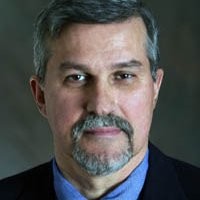 Adjunct Associate Professor, M.B.A. Program
Adjunct Associate Professor, M.B.A. Program
Expertise: Business and finance
View profile

Going green: National mental health awareness movement reaches Winona Campus
Student-driven cause is part of larger campus initiative that launched in 2019
This semester, the Winona Campus at Saint Mary’s University of Minnesota may look a little greener than usual.
That’s because 55 student-athletes will have specialized lime green bandanas on their backpacks as part of what has become a national movement called the Green Bandana Project.
Anyone with the bandana indicates to passersby that they are a safe individual to approach with mental health-related issues and can provide cards containing additional resources, such as those listed on this PDF, located inside their accompanying mental health resource tags.
“It’s a sign that someone is always there for you,” said Justine Schultz, a junior from Winona who has helped spearhead the movement at Saint Mary’s, of the bandanas and tags. “You might not think someone will be open to talk to you, but someone will always be there to listen.”
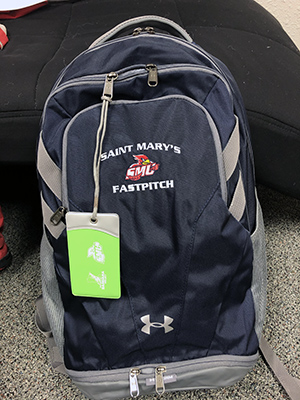
Those who receive the certified training will receive a lime green mental health resource tag along with a matching bandana that will be tied to their backpacks.
What began in 2016 at the University of Wisconsin-Madison with a first-year student handing bandanas to fellow students has blossomed into a large initiative to raise awareness of mental health on college campuses. Participating campuses include the University of Minnesota; Minnesota State University, Mankato; St. Olaf University; and Winona State University.
When Karen Hemker M’04, director of Access Services in the Student Success Center, heard that a group of student-athletes from Winona State had started a chapter on their campus, she decided the initiative would be a perfect way to help reinforce an ongoing commitment to mental health awareness made in the university’s strategic plan that began with the formation of the Mental Health Task Force in spring 2019.
As fate would have it, Schultz is a student worker in Hemker’s office. Given that Schultz is not only a psychology major but also a catcher on the softball team, Hemker asked if she would be interested in drumming up support from fellow student-athletes on campus, as Hemker was aware of Schultz’s passion for supporting students with mental health issues on campus. Schultz quickly got on board, as did Samantha Borawski ’15, M’17, an assistant coach on the softball team who also serves as an advisor to the Student-Athlete Advisory Committee (SAAC).
The green mental health resource tags feature both the Green Bandana Project logo as well as the university’s logo.
“We said, ‘If we are starting this chapter at Saint Mary’s, we want students to be proud to be a part of the project.’ We thought that personalizing the resource items would be a nice little touch for those who do choose to complete the training,” Borawski said of the specialized tags and bandanas.
In her research, Hemker noticed that different chapters required different amounts of involvement. On some campuses, students only had to take an oath to get the green bandana or tag.

The digital depiction of what the new green bananas will look like, featuring both the Saint Mary’s logo and the Green Bandana Project logo.
“We wanted to participate, but we also wanted to support our students by giving them additional training in mental health, rather than just have them sign a pledge,” Hemker said. “It was important to us to have a more structured program so students were using the correct language and had some training.”
To receive a tag, students have to complete a two-hour training session. The first was conducted on Jan. 12 with 55 student-athletes led by Connie Mettille, a professor at Winona State, who is heavily involved in making students, faculty, and staff at Winona State aware of mental health issues. — Karen Hemker
Mettille also led the training sessions of an eight-hour Mental Health First Aid class based on material from the National Council for Behavioral Health that was initially offered to faculty and staff at Saint Mary’s and later to resident assistants and other student leaders. Hemker, Borawski, and Schultz had all undergone this training in the spring.
“We wanted to participate, but we also wanted to support our students by giving them additional training in mental health, rather than just have them sign a pledge.”
–Karen Hemker
The trio was pleased with the level of engagement the student-athletes displayed for the inaugural training session; several teams have expressed interest in going through the eight-hour training together. They hope to offer more training sessions later this spring, as the overall goal is to train anyone who is interested in serving as a resource to support mental health issues within the university community, Hemker said.
Borawski and Hemker expressed their gratitude to the administration for supporting this initiative. Faculty and staff members who have been through the Mental Health First Aid training will also be provided green bandanas to make students aware of the support among the faculty and staff as well.
Featured image: The inaugural training for the Saint Mary’s chapter of the Green Bandana Project on the Winona Campus took place on Jan. 12. Fifty-five student-athletes took part. Those in charge hope to have another training session for all students later in the spring.

Finding a match: Former Cardinal tennis star takes passion for game to the working world
Laura Sonday ’19 did not plan on falling in love with Saint Mary’s University of Minnesota. After having two older sisters (Mara ’10, C’17, M’18 and Anna ’13) and her mother, Mooreen M’04, attend the university, she liked the idea of blazing her own trail at a different school after graduating as a tennis standout from South St. Paul High School in 2015. But fate had other ideas.
“I tried to tell myself I wasn’t going to come to Saint Mary’s because my sisters both did, but then I went on campus and met with Coach [Jeff] Halberg and the girls who were on the team at the time,” recalls Sonday, who is a native of West St. Paul. “I just felt like they cared what my opinion was. They cared about me and what I wanted to talk about.”
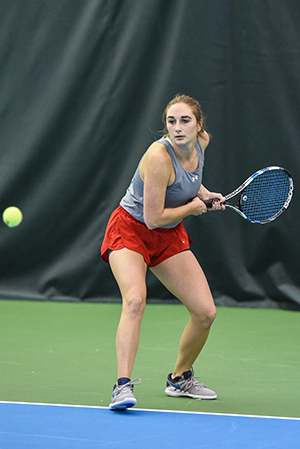
During her four years as a member of the Saint Mary’s women’s tennis team, Laura Sonday ’19 played No. 1 singles and doubles, compiling a combined record of 112-65. This spring, she will return to the team as a volunteer assistant coach.
Sonday, who double majored in marketing and Spanish, was impressed with how Halberg personally set up a meeting with Christian Michener, Ph.D., the director of the Lasallian Honors Program, and walked with her to the meeting when she was on her campus visit.
Sonday finished her career at Saint Mary’s playing No. 1 singles and doubles for all four years with a combined record of 112-65 and five All-Minnesota Intercollegiate Athletic Conference (MIAC) First-Team honors. Her academic accomplishments were just as impressive as a four-time ITA Scholar-Athlete and three-time All-MIAC Academic selection. Last season, she was selected for the MIAC Chris Evert Award, given annually to a “senior tennis student-athlete who exhibits outstanding sportsmanship and exemplary athletic, academic, and humanitarian accomplishments,” according to the MIAC.
“She left such a lasting impact because she’s just such a generous and selfless person who gave so much of herself to the team and to the school,” Halberg says.
Now, after four years in Winona, Sonday finds herself back in the Twin Cities and part of a new team that still allows her passion for tennis to burn bright. Since July, Sonday has been working as a media and marketing coordinator for Bleachr, a mobile sports app startup company based in downtown Minneapolis.
Bleachr began in 2015 with the Saint Paul Saints minor league baseball team as its first client, developing a fan experience app to allow fans to enter contests, order tickets for future games, and access other amenities. The company has since expanded into three branches: BaseballONE (minor league baseball teams), CollegeONE (major college athletics), and Sonday’s favorite, TennisONE (professional tennis tournaments).
‘A kid in a candy store’
As part of the marketing team, Sonday started her new job by going to four professional tennis tournaments across the country, beginning with the Hall of Fame Open in Newport, R.I., the only grass-surface tournament of its kind in the U.S.
“I was like a kid in a candy store,” Sonday said. “It was amazing. There’s just so much tennis history there. It’s such a small, intimate tournament where players are just walking around.”
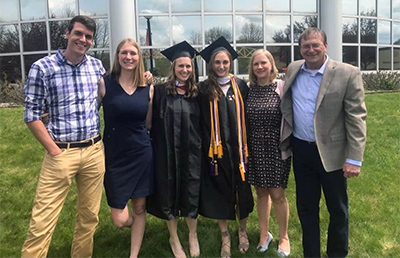
The Sondays are no strangers to Saint Mary’s, having six degrees from the university between the seven of them (from left): Sam (Olsem) ’13, Anna ’13 (Sam’s spouse), Mara ’10, C’17, M’18; Laura ’19, Mooreen M’04 and Dave at the spring 2019 commencement.
Bleachr had built an app specifically for each tournament. While on assignment, Sonday and her fellow team members help patrons download that event’s app and answer any questions they may have.
“And then I get to watch pro tennis when it’s not busy, which is amazing,” added Sonday, who grew up cheering for tennis icons Roger Federer and Serena Williams. “And I get to write about all of my experiences.”
Currently, Bleachr creates apps for tournaments in four different countries: U.S., Canada, France, and Switzerland. Sonday hopes the operations might expand to Spanish-speaking countries in the future, allowing her to keep her Spanish skills fresh.
It should be noted that as part of her thesis, she translated some of the university’s admission materials into Spanish. Said Sonday: “We have such a strong First Generation Initiative program with people who are bilingual. Everyone deserves to have materials in a language they and their families are comfortable in.”
When Sonday first thought of a possible career, she envisioned herself running tournaments such as the ones where she has worked. Her perspective, though, has changed.
“Now that I’ve been there and seen how much work there is, maybe not. But just being able to go and still be a part of that is definitely as close to a dream job as I think you can get,” Sonday said.
“She left such a lasting impact because she’s just such a generous and selfless person who gave so much of herself to the team and to the school.”
—Jeff Halberg, women’s tennis coach
Sonday is especially excited about the launch of Bleachr’s TennisONE app, the first proprietary venture for the company. It features a wide array of platforms for fans of the game, including news, live scores, draws, and interactive gaming.
She finds daily inspiration from Bleachr’s co-founder and CEO Kristin Geer, who reached out to Sonday through LinkedIn.
“She motivates me to make a path for myself as a professional woman,” Sonday said of Geer.
Last September, Sonday attended a “Women in Tech” event sponsored by Minne Inno when she heard something that has stuck with her: Oftentimes, in a room, men find it very easy to go up to people to network. Women don’t always find it so easy because they don’t like to interrupt. If you can go into those networking situations with a friend, though, it can be less intimidating.
“I’ve never heard somebody give that advice before,” Sonday said. “They always want you to be strong and independent, but you can do that with support.”
A new season
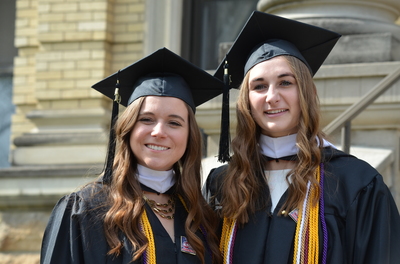
Laura Sonday ’19 takes a photo with Julia Boeve ’19 (St. James, Minn.), fellow senior on the women’s tennis team, during the spring 2019 commencement on the Winona Campus.
Although Sonday’s time as a player with the Cardinals has ended, Saint Mary’s fans will be able to see her at the Winona Tennis Center in a different capacity, as she will be serving as a volunteer assistant coach for Halberg. The season begins Jan. 24, with a match against Martin Luther College at the center.
“I always tell my players that the measure of success is not how much you make but whether you enjoy what you do and find real value in it,” Halberg said. “Laura does, and I’m so pleased for her because that’s really the holy grail.”
Sonday says that she will continue to balance the weekend drives to Winona in the spring with her job in Minneapolis for as long as Halberg will have her on staff. It’s a commitment she is willing to make given her passion for both pursuits.
“I’m not looking for a place that’s a stepping stone,” Sonday says of her job at Bleachr. “I’m looking for a place that I can grow with and that I can help grow. And this seems like a place for that. The good news about a startup is that you often get to help shape your own role.
“I see myself here in the Twin Cities for a long time, still at Bleachr with hopefully some Grand Slam [major tournaments] under our belt.”
Featured image: Laura Sonday ’19 has been working in the marketing department for Bleachr, a company that develops fan experience apps for professional sports teams, college athletic programs, and tournaments.
Saint Mary’s University announces December 2019 graduation list
WINONA, Minn. — The following Saint Mary’s University of Minnesota students completed requirements for bachelor of arts degrees in December 2019.
Carley Cronen, daughter of Michael and Debra Cronen, Kandiyohi, Minn.
Mariah D’Souza, daughter of Roger and Meggin D’Souza, Burnsville, Minn.
Samuel Eggebrecht, son of Roger and Ann Eggebrecht, Rochester, Minn.
Lily Figel, daughter of William Figel, Chicago, Ill.
Max Heukeshoven, son of Eric and Janet Heukeshoven, Winona, Minn.
Ashley Hill, daughter of Kevin and Nancy Hill, Champlin, Minn.
Trenton Jancze, son of Mark and Krystal Jancze, Woodbury, Minn.
Jack Knoblauch, son of Rainer and Cristin Knoblauch, Coon Rapids, Minn.
Nicholas Marshall, son of Thomas Marshall, Minneapolis, Minn.
Casey McCarraher, daughter of Keith and Deanne McCarraher, New Vienna, Iowa
Hailey Nisbit, daughter of Sherry Nisbit, Utica, Minn.
Mara Novakovic, daughter of Alex and Marianne Novakovic, Mokena, Ill.
Mia Ojczyk, daughter of Joe and Cindy Ojczyk, White Bear Lake, Minn.
Emily Seykora, daughter of Joseph and Ann Seykora, Eaton Rapids, Mich.
Nicholas Shelquist, son of Peter and Kelly Shelquist, Minnetonka, Minn.
Andrea Speltz, daughter of Peter and Maureen Speltz, Rollingstone, Minn.
Lillian Sterling, daughter of Ann Elliott, Minneapolis, Minn.
Cameron Taylor, daughter of Michael Taylor and Karen Terhaar, Minneapolis, Minn.
Caitlin Wallerus, daughter of Paul and Dawn Wallerus, Osseo, Minn.
Emily Wallrich, daughter of James and Jane Wallrich, Saint Paul, Minn.
Kierra Walske, daughter of Lori Walske, Rochester, Minn.
Charles Westholm, son of Fred and Rebecca Westholm, Kellogg, Minn.
Quinncy Zupko, daughter of Craig and Kerry Zupko, Wyoming, Minn.



